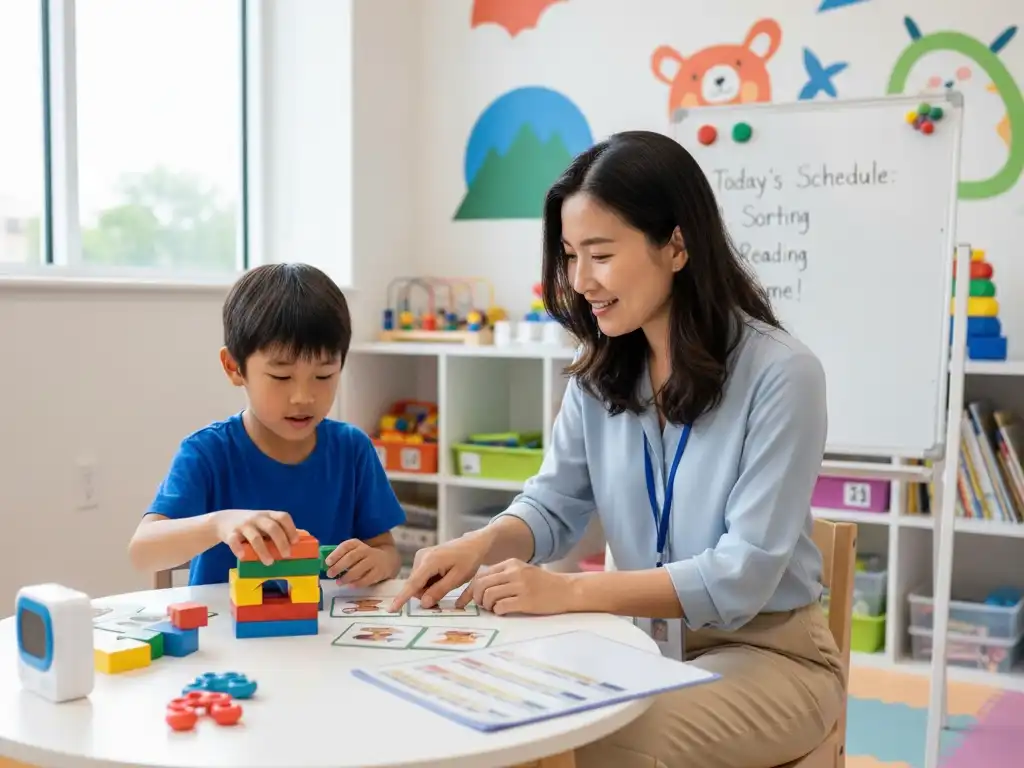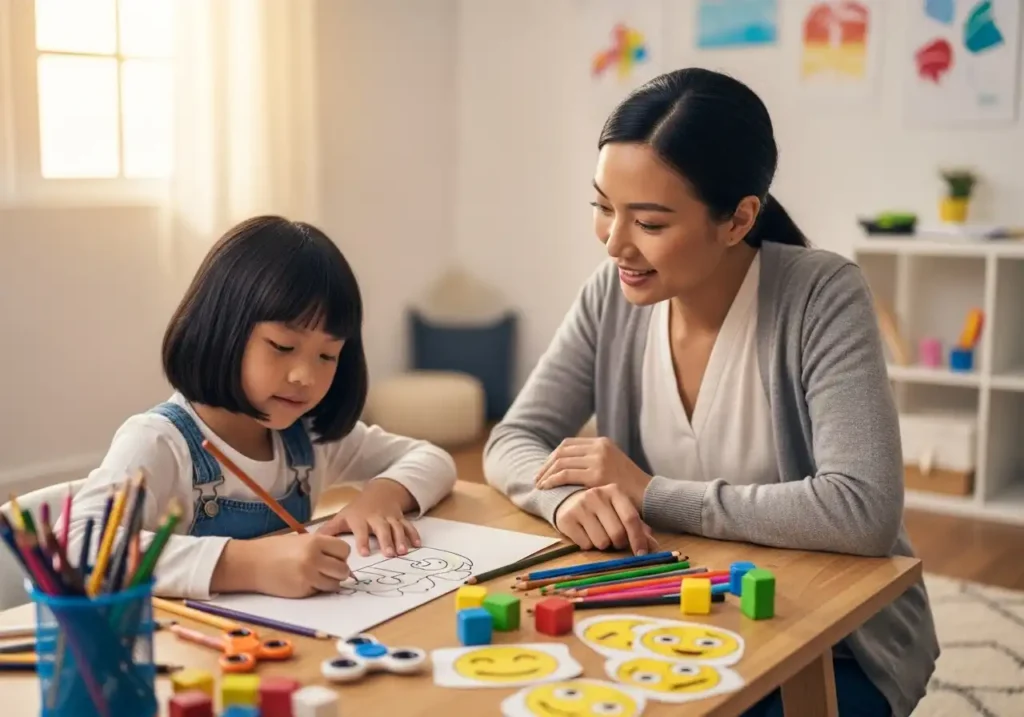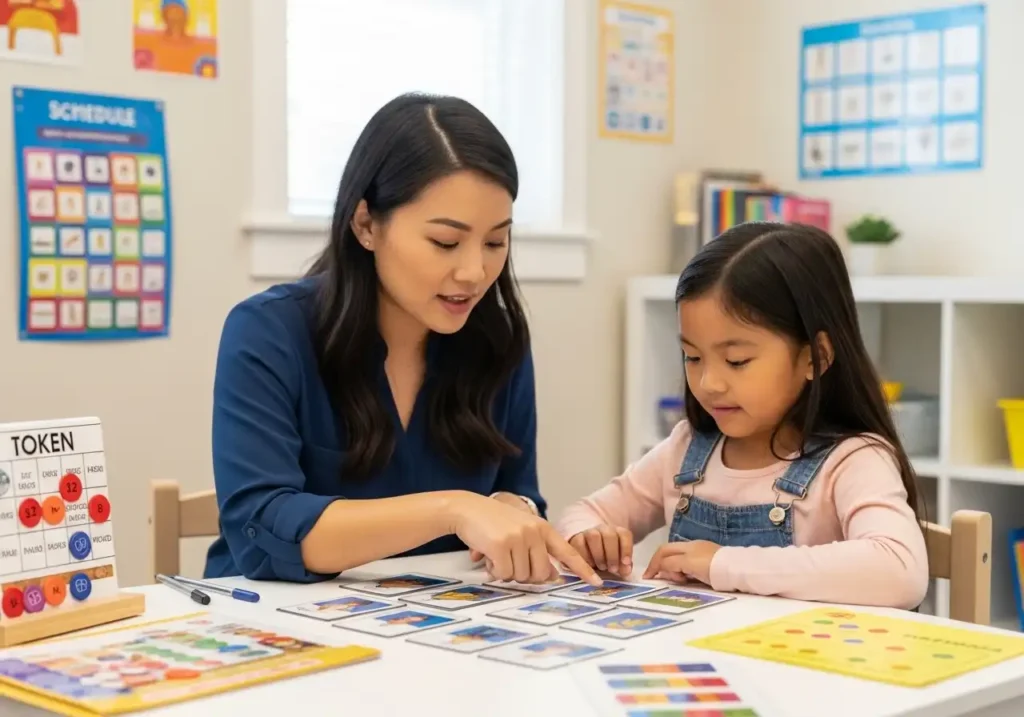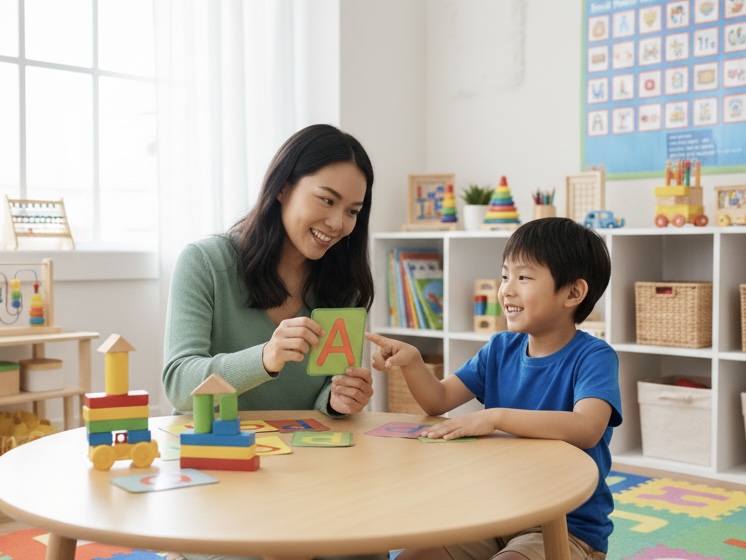As a parent, you’ve probably asked yourself a hundred times, “What is the best way to help my child?” When your child is on the autism spectrum or has ADHD, this question can feel even bigger. You want what’s best, but sorting through all the different therapies can be confusing and overwhelming.
At Tesserae, we are the first and only Applied Behavior Analysis (ABA) practice in Southeast Asia led by a practicing Doctoral-level Board Certified Behavior Analyst (BCBA-D). We specialise in progressive and collaborative ABA therapy and understand the journey you’re on. This guide will help you understand what ABA therapy involves and whether it might be the right next step for your child.
Applied Behaviour Analysis (ABA) is a scientific approach that uses evidence-based techniques to help children develop essential life skills whilst reducing challenging behaviours.

ABA therapy is all about figuring out why a certain behaviour happens and then teaching practical, functional, and meaningful skills while reducing barriers that get in the way of learning, communication, and independence. It looks at the “A-B-C” of behaviour:
Antecedent
(what happens right before the behaviour)
Behaviour
Consequence
(what happens right after)
By understanding this pattern, a therapist can change the environment or the reaction to help the child learn. For example, if a child screams to get a toy (A), the screaming is the Behaviour, and getting the toy is the Consequence. An ABA therapist would work on teaching the child to ask for the toy using words or a picture instead.
ABA differs from other therapies because it focuses on changing specific behaviours rather than exploring underlying emotions or thoughts. This doesn’t mean emotions aren’t important – it simply means ABA tackles problems by teaching new skills and reducing problematic behaviours through proven techniques.
Positive reinforcement at the core – modern ABA therapy focuses on what motivates each child, using praise, playtime, or favourite items to encourage learning.
Individualised motivation strategies – therapists tailor rewards to each child’s preferences to build skills and confidence.
Data-driven progress tracking – detailed records on behaviours and skill acquisition guide therapy decisions and ensure measurable results.
Practical skill development – structured tracking helps children master everyday tasks, from communication to self-care.
Functional behaviour assessment (FBA) – therapists analyse the root causes of behaviours, such as sensory overload or communication barriers.
Personalised treatment plans – by understanding the ‘why’ behind behaviours, ABA therapy creates more effective, child-centred interventions.
A typical ABA session can vary quite a bit. It could be a one-on-one session at our centre, at home, or even at the child’s school.
Length, frequency, and duration of sessions depend on the child’s specific needs and goals. For example, younger children that require the learning of more foundational skills may require longer and more frequent sessions (e.g. 3 to 6 hours twice a week) over a shorter period of time, while programs targeting specific skills may only require a small number of hours each week (e.g. 3 hours once a week) over a longer period of time.
The best approach for each child depends on their unique needs, and we’ll work with you to find the right fit.

ABA therapy is unique because it uses data-driven strategies to teach and strengthen specific skills, often breaking them down into smaller steps. Other therapies focus on different areas, for example:
ABA therapy works well alongside other interventions like speech therapy, occupational therapy, and educational support. The key is ensuring all team members communicate and coordinate their approaches to avoid confusion or conflicting strategies.
For example, speech therapy and ABA therapy have complementary strategies and foundational theories (e.g. B.F. Skinner’s Verbal Behaviour). Speech therapists can address specific communication challenges whilst ABA techniques help children generalise new communication skills across different settings and situations.
While ABA provides a strong evidence-based foundation, our team collaborates closely across therapies so that strategies are integrated rather than siloed. This way, your child benefits from a holistic plan that is tailored to their unique learning style, developmental needs, and family context.
We believe therapy should empower, not conform. Our approach is built on a foundation of assent-based practice, meaning we teach skills through positive reinforcement and collaboration, not by demanding compliance. We respect an individual’s right to say “no” and make choices, fostering a sense of control and self-determination from the very first session.
Our methods are exclusively positive reinforcement-based and compassionate. We do not use punishment or aversive techniques of any kind. Instead, we focus on understanding the function of a behaviour and teaching meaningful replacement skills in ways that are positive, engaging, fun, and natural.
We don’t believe in “fixing” an individual. Our goal is to help individuals build skills that improve their quality of life, not to suppress natural autistic behaviours like stimming or the lack of eye contact. We celebrate neurodiversity and create personalised goals that honour a client’s unique strengths and interests.
At Tesserae, every programme is designed and supervised by highly qualified professionals. ABA is a specialised field that requires rigorous training, a minimum of a master’s degree, and board certification (BCBA or higher) to practice independently. Our team is led by BCBAs and BCBA-Ds, representing the highest credential in the field. This ensures that intervention plans are not only evidence-based but also clinically sound, ethical, and held to the global gold standard of practice.
We believe that no single discipline holds all the answers. At Tesserae, our transdisciplinary model reduces the inefficiency of families needing to move from centre to centre, repeating assessments, or receiving conflicting recommendations. By collaborating across ABA, speech therapy, occupational therapy, counseling, and more within our ecosystem, we save families time, reduce unnecessary costs, and prevent competition between professionals. The result is a seamless plan of care that prioritises what matters most: consistent, efficient, and holistic support for the child and family.

Research consistently demonstrates that quality ABA therapy can lead to meaningful improvements in communication, social interaction, and daily living skills. However, it’s worth noting that every child responds differently, and progress varies based on individual factors like age, severity of challenges, and family involvement.
ABA therapy can be particularly effective for children struggling with communication challenges. Therapists work on both expressive language (helping children communicate their wants and needs) and receptive language (understanding what others say to them).
Verbal behaviour techniques focus on teaching children why we communicate, and not just how to say words, but how to use language functionally. For example, rather than just teaching a child to say “biscuit,” ABA helps them understand when and how to request biscuits in different situations.
For non-speaking children, alternative and augmentative communication (AAC) strategies might include picture exchange systems (PECs), sign language, or communication devices. The goal isn’t necessarily spoken language, it’s helping each child find their most effective way to communicate with the world around them.
Many children struggle with peer interactions, not because they don’t want friends, but because they haven’t learned the subtle rules of social communication. ABA therapy breaks down social skills into teachable components – making appropriate eye contact, taking turns in conversation, understanding social rules in various settings, reading facial expressions, taking feedback, and understanding personal space.
Reducing challenging behaviours often becomes easier once children have better ways to communicate their needs and cope with challenges. Rather than having meltdowns when frustrated, children learn to ask for help or take breaks. Instead of aggressive behaviour during play, they develop sharing and negotiation skills.
Self-regulation and coping strategies form a crucial part of modern ABA programmes. Children learn to recognise their own emotions and develop tools for managing overwhelming situations. These might include deep breathing techniques, requesting breaks, or using visual schedules to prepare for changes.

School readiness preparation goes beyond academic knowledge. ABA therapy helps children develop the foundational skills needed for classroom success – sitting appropriately, following group instructions, raising hands to ask questions, and transitioning between activities. Daily living skills training covers everything from brushing teeth and getting dressed to more complex skills like preparing simple meals or managing money. These skills directly impact a child’s independence and quality of life as they grow older.
The ultimate goal is promoting independence. Rather than creating dependency on adult support, quality ABA programmes systematically fade assistance as children master new skills, helping them become as independent as possible.
It’s a really common misconception that ABA therapy is only to address autism spectrum disorder (ASD). While it is widely used and well-regarded for helping children with ASD , the principles of ABA therapy can be helpful for a much broader range of individuals.
The core of ABA therapy is a data-driven approach to understanding and changing behavior, and it can be effective for people of all ages with different conditions. Here are some examples:

ABA therapy isn’t a one-size-fits-all approach. Different methods work better for different children, and many programmes combine multiple techniques to create comprehensive treatment plans tailored to individual needs.
Discrete Trial Training (DTT) is a structured way of teaching. It involves breaking down a skill into a series of small, teachable steps.
Each step is taught separately, and the child gets a lot of practice with each step. For instance, if the goal is to teach a child to identify a red ball, the therapist might present two objects and ask, “Which one is red?” If the child points to the ball, they get a reward.
This process is repeated many times until the child masters the skill. DTT can be really effective when a child is learning a brand-new skill for the first time, as it provides a clear and consistent way to learn.
In contrast to DTT, Natural Environment Teaching (NET) is more about play-based learning strategies. Instead of practising requesting at a table, children might learn to ask for toys during playtime or request snacks in the kitchen.
Play-based learning strategies make therapy feel less like work and more like fun. Children are more motivated to learn when activities match their interests and preferences.
This method is good for helping a child use their new skills in a lot of different places and with different people, a concept called generalisation of skills. Parent and caregiver involvement is really key here, since the skills are meant to be used at home and in the community.
Pivotal Response Treatment (PRT) focuses on developing “pivotal” skills that unlock broader learning across multiple areas.
Rather than teaching individual behaviours one at a time, PRT targets skills like motivation, self-initiation, and responsiveness to multiple cues. This child-directed approach follows the child’s interests and motivation rather than forcing predetermined activities. If your child loves bubbles, PRT might use bubble play to work on communication, social interaction, and play skills all at once.
This approach is very much a family-centred intervention, as it requires parents and caregivers to be involved in the therapy and learn to use the strategies in their daily lives.
TIP is a structured method designed to build social skills. It goes beyond simply telling a child what to do by including explanation, rationale, modelling, role-play, and feedback.
For example, when teaching how to join a group activity, the therapist explains the steps, shows the child how it’s done, role-plays the scenario with them, and then provides constructive feedback.
This helps children understand not only how to behave but also why these social behaviours are important, making them more flexible and natural in real situations.
Many challenging behaviours happen because children do not yet have an effective way to express their needs.
FCT directly teaches replacement communication, whether through speech, signs, or augmentative devices. For example, instead of crying or hitting to ask for help, a child learns to say, “Help me,” or use a communication card.
Giving children a reliable voice often reduces frustration and builds confidence.
Finding the right ABA provider can feel overwhelming, especially when you’re already managing your child’s various needs. However, knowing what to look for can help you make confident choices about your child’s therapy team.

When looking for a provider, you’ll likely come across a couple of key titles:
At Tesserae, our Clinical Director, Dr Dominic Leong, is Southeast Asia’s only practicing Doctoral-level Board Certified Behavior Analyst-Doctoral (BCBA-D), the most advanced international credential in ABA.
During initial consultations, ask about the provider’s experience with children similar to yours. How long have they been providing ABA therapy? What specific training do their staff members receive? How do they measure and report progress?
Enquire about their approach to family involvement. Quality programmes recognise that parents are crucial partners in their child’s development. Will you receive training on implementing strategies at home? How often will you receive progress updates?
Ask about their philosophy regarding modern ABA practices. Do they emphasise positive reinforcement over punishment-based procedures? How do they ensure therapy remains child-friendly and developmentally appropriate?
Understanding the cost of ABA therapy is an important step for families. At Tesserae, we believe in transparency so you can make confident, informed choices.

ABA therapy costs vary based on intensity, location, and provider qualifications.
In Singapore, private ABA therapy might range from $100-200 per hour, with comprehensive programmes potentially costing several thousand dollars monthly. If insurance doesn’t cover all of it, parents might have to pay for a portion of the costs themselves. It’s always best to get a clear breakdown of the costs from any potential provider and to ask about any payment plans they might have.
We believe that therapy should be accessible, so we’re always ready to talk through the different options and help you figure out what might work for your family.
Insurance coverage for ABA therapy varies considerably depending on your specific policy and insurance provider. In Singapore, some international insurance plans may cover ABA therapy, whilst others may require prior authorisation or have specific coverage limits. Typically, insurance plans require that programs are planned and supervised by a qualified BCBA or BCBA-D.
If insurance doesn’t cover ABA therapy, explore alternative funding options. Some employers offer employee assistance programmes, and certain government agencies may provide support for children with developmental disabilities.
If you’ve read this far, it’s probably because you’re weighing up whether ABA therapy could be a good fit for your child. Taking that initial step to get support can feel like a huge decision, but you should know that even considering it speaks volumes about your commitment to your child’s well-being.
Want to find out if ABA Therapy is suitable for your child?
Disclaimer: This information is for educational purposes only and should not replace professional medical advice. Always consult with qualified healthcare professionals about your child’s specific needs and treatment options.
Book a free discovery call with us